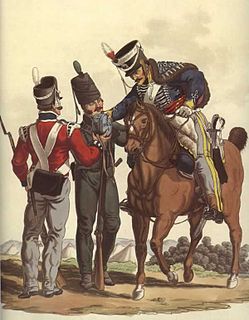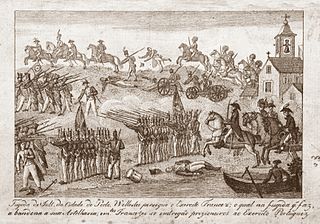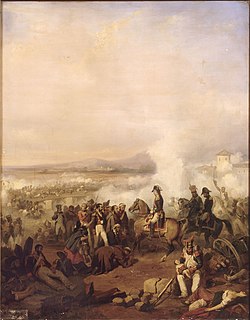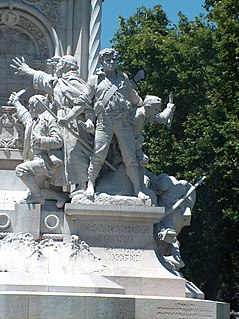
The Battle of Salamanca on 22 July 1812 was a battle in which an Anglo-Portuguese army under the Earl of Wellington defeated Marshal Auguste Marmont's French forces at Arapiles, south of Salamanca, Spain, during the Peninsular War. A Spanish division was also present but took no part in the battle.

In the Battle of Roliça an Anglo-Portuguese army under Sir Arthur Wellesley defeated an outnumbered Imperial French division under General of Division Henri François Delaborde, near the village of Roliça in Portugal. The French retired in good order. Formerly spelled Roleia in English, it was the first battle fought by the British army during the Peninsular War.

Swiss mercenaries (Reisläufer) were notable for their service in foreign armies, especially the armies of the Kings of France, throughout the Early Modern period of European history, from the Later Middle Ages into the Age of Enlightenment. Their service as mercenaries was at its peak during the Renaissance, when their proven battlefield capabilities made them sought-after mercenary troops. There followed a period of decline, as technological and organizational advances counteracted the Swiss' advantages. Switzerland's military isolationism largely put an end to organized mercenary activity; the principal remnant of the practice is the Pontifical Swiss Guard at the Vatican.

The King's German Legion was a British Army unit of mostly expatriated German personnel during the period 1803–16. The legion achieved the distinction of being the only German force to fight without interruption against the French during the Napoleonic Wars.

The Battle of Talavera was fought just outside the town of Talavera de la Reina, Spain some 120 kilometres (75 mi) southwest of Madrid, during the Peninsular War. At Talavera, an Anglo-Spanish army under Sir Arthur Wellesley combined with a Spanish army under General Cuesta in operations against French-occupied Madrid. The French army withdrew at night after several of its attacks had been repulsed.

The Battle of Bailén was fought in 1808 between the Spanish Army of Andalusia, led by Generals Francisco Castaños and Theodor von Reding, and the Imperial French Army's II corps d'observation de la Gironde under General Pierre Dupont de l'Étang. This battle was the first open-field defeat of a Napoleonic army. The heaviest fighting took place near Bailén, a village by the Guadalquivir river in the Jaén province of southern Spain.

The Battle of the Pyrenees was a large-scale offensive launched on 25 July 1813 by Marshal Nicolas Jean de Dieu Soult from the Pyrénées region on Emperor Napoleon’s order, in the hope of relieving French garrisons under siege at Pamplona and San Sebastián. After initial success the offensive ground to a halt in the face of increased allied resistance under the command of Arthur Wellesley, Marquess of Wellington. Soult abandoned the offensive on 30 July and headed toward France, having failed to relieve either garrison.

The Battle of Orthez saw the Anglo-Spanish-Portuguese Army under Field Marshal Arthur Wellesley, Marquess of Wellington attack an Imperial French army led by Marshal Nicolas Soult in southern France. The outnumbered French repelled several Allied assaults on their right flank, but their center and left flank were overcome and Soult was compelled to retreat. At first the withdrawal was conducted in good order, but it eventually ended in a scramble for safety and many French soldiers became prisoners. The engagement occurred near the end of the Peninsular War.

The two Battles of the Bruch(Spanish: Batallas del Bruch; Catalan: Batalles del Bruc) were engagements fought successively between French columns commanded by Brigadier General François de Schwarz and General of Division Joseph Chabran, and a body of Catalan volunteers and mercenaries led by General Antoni Franch i Estalella and Joan de la Creu Baiget, during the Peninsular War. The result of these battles and actions fought at El Bruc, near Barcelona, Catalonia, between 6–14 June 1808 was a Spanish victory. The Spanish also captured a French Imperial Eagle, adding to defeat a humiliation for the French army.

The Second Battle of Porto, also known as the Battle of the Douro or the Crossing of the Douro, was a battle in which General Arthur Wellesley's Anglo-Portuguese Army defeated Marshal Nicolas Soult's French troops on 12 May 1809 and took back the city of Porto. After taking command of the British troops in Portugal on 22 April, Wellesley immediately advanced on Porto and made a surprise crossing of the Douro River, approaching Porto where its defences were weak. Soult's late attempts to muster a defence were in vain. The French quickly abandoned the city in a disorderly retreat.

The Battle of Villafranca del Bierzo took place on 17 March 1809, during the French occupation of León in the Peninsular War. After a bloody four-hour siege the small and isolated French garrison at Villafranca surrendered to Spanish regulars under Brigadier José de Mendizábal and General Pedro Caro, 3rd Marquis of la Romana.

In the First Battle of Porto the French under Marshal Soult defeated the Portuguese, under General Parreiras, outside the city of Porto during the Peninsular War. Soult followed up his success by storming the city.

In the Battle of García Hernández on 23 July 1812, two brigades of Anglo-German cavalry led by Major-General Eberhardt Otto George von Bock defeated 4,000 French infantry led by Major-General Maximilien Foy. In what would otherwise have been an unremarkable Peninsular War skirmish, the German heavy dragoons achieved the unusual feat of breaking three French squares, those of the 6th, 69th and 76th Line, routing the entire French force with heavy losses.

In the Battle of Mansilla or Battle of Mansilla de las Mulas on 30 December 1808 an Imperial French corps led by Nicolas Soult caught up with a Spanish corps commanded by Pedro Caro, 3rd Marquis of la Romana. Soult's cavalry under Jean Baptiste Marie Franceschi-Delonne overran la Romana's rear guard led by General Martinengo. Mansilla de las Mulas is a town located 17 kilometres (11 mi) southeast of León, Spain. The combat occurred during the Peninsular War, part of the Napoleonic Wars.

The Invasion of Portugal saw an Imperial French corps under Jean-Andoche Junot and Spanish military troops invade the Kingdom of Portugal, which was headed by its Prince Regent João of Bragança. The military operation resulted in the occupation of Portugal. The French and Spanish presence was challenged by the Portuguese people and by the United Kingdom in 1808. The invasion marked the start of the Peninsular War, part of the Napoleonic Wars.

Jacques Thomas Sarrut joined the French army and became a division commander in the First French Empire of Napoleon. He led a regiment at Hohenlinden, a brigade at Jena, Bussaco, and Fuentes de Onoro, and a division at Salamanca. He was mortally wounded while leading his soldiers against the Anglo-Allied army at the Battle of Vitoria. Sarrut is one of the names inscribed under the Arc de Triomphe on Column 21.

The Battle of Tolosa saw a British-Portuguese-Spanish column led by Thomas Graham attempt to cut off a retreating Franco-Italian force under Maximilien Sébastien Foy. Assisted by Antoine Louis Popon de Maucune's division, which fortuitously appeared, the French parried Graham's initial attacks then slipped away when threatened with envelopment. The town of Tolosa is located about 20 kilometres (12 mi) south of San Sebastián. The clash occurred during the Peninsular War, part of the wider Napoleonic Wars.

Dominique Honoré Antoine Vedel was a French general who participated in the French Revolution, the War of the Fourth Coalition and the Peninsular War.

The Spanish Army of the Peninsular War refers to the Spanish military units that fought against France's Grande Armée from 2 May 1808 (the Peninsular War began 27 October 1807 with the Franco-Spanish invasion of Portugal) to 17 April 1814) a period which coincided with what is also termed the Spanish War of Independence.

The Cardedeu order of battle lists the troops that fought in the Battle of Cardedeu and several other battles fought between June and December in the Spanish province of Catalonia during the Peninsular War. In February 1808, Imperial French forces treacherously seized Barcelona on 29 February and Sant Ferran Castle on 15 March as well as other fortresses in Spain. The Dos de Mayo Uprising broke out when the Spanish people found that Emperor Napoleon deposed the Spanish royal family and set up his brother Joseph Bonaparte as their new king. The 12,000 Imperial French soldiers under Guillaume Philibert Duhesme occupying Catalonia were beaten at the Battles of El Bruch and Gerona in June. Though Duhesme was reinforced by another French division, the Spanish defeated him at the Second Siege of Gerona in July and August. With Duhesme blockaded in Barcelona, Napoleon appointed Laurent Gouvion Saint-Cyr as commander of the VII Corps, added two good divisions and other troops to his force, and ordered him to relieve Barcelona. Saint-Cyr succeeded in this task, winning the battles of Roses, Cardedeu and Molins de Rei in December.




















